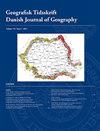基于百度地图全景图像数据的城市街道绿化分布研究
IF 1.1
4区 社会学
Q4 ENVIRONMENTAL STUDIES
Geografisk Tidsskrift-Danish Journal of Geography
Pub Date : 2021-12-29
DOI:10.1080/00167223.2021.2019073
引用次数: 2
摘要
利用绿色景观指数(GVI)对街道绿化进行分析越来越受到人们的关注。现有的植被提取方法不适合处理大量数据。本研究引入可视植被差异指数(VDVI)对百度地图全景静态图像进行处理,相对方便GVI的计算。利用该方法对广州市街道绿化的空间分布进行了分析。结果表明:(1)广州市GVI值的空间分布具有明显的集聚性。(2)分析了街道绿化分布的平均水平和均匀度。天河区和越秀区街道绿化水平较高,分布均匀;荔湾、海珠区、黄埔区和番禺区街道绿化水平较好,但分布不均;白云和南沙的街道绿化水平较低。(3)道路等级、房价、楼龄、土地利用与GVI值存在显著相关,揭示了广州市GVI值分布的驱动因素。该方法的GVI计算方法相对方便、准确。GVI可作为城市规划中街道绿化评价的新工具,也可作为城市环境研究的指标。本文章由计算机程序翻译,如有差异,请以英文原文为准。
Exploring the distribution of city street greenery from eye-level: an application of Baidu Map panoramic images data
ABSTRACT Increasing attention has been paid to the analysis of street greenery using the Green View Index (GVI). Current methods of vegetation extraction are not suitable for processing large amounts of data. This study introduces Visible Difference Vegetation Index (VDVI) to process Baidu Map panoramic static images which is relatively convenient for GVI calculation. The method is used to analyse the spatial distribution of street greenery in Guangzhou city in China. The results show that: (1) The spatial distribution of GVI values in Guangzhou show obvious agglomeration. (2) The average level and evenness of street greenery distribution is analysed. Tianhe and Yuexiu districts had high levels of evenly distributed street greenery; Liwan, Haizhu, Huangpu, and Panyu districts had good levels of street greenery but uneven distributions; Baiyun and Nansha had low levels of street greenery. (3)There is a significant correlation between road grade, house price, building age, land use and GVI values, which reveals the driving factors of GVI value distribution in Guangzhou. The GVI calculation method in this method is relatively convenient and accurate. GVI can be a new evaluation tool for street greenery in urban planning, additionally used as an index for urban environmental research.
求助全文
通过发布文献求助,成功后即可免费获取论文全文。
去求助
来源期刊
CiteScore
5.20
自引率
0.00%
发文量
5
期刊介绍:
DJG is an interdisciplinary, international journal that publishes peer reviewed research articles on all aspects of geography. Coverage includes such topics as human geography, physical geography, human-environment interactions, Earth Observation, and Geographical Information Science. DJG also welcomes articles which address geographical perspectives of e.g. environmental studies, development studies, planning, landscape ecology and sustainability science. In addition to full-length papers, DJG publishes research notes. The journal has two annual issues. Authors from all parts of the world working within geography or related fields are invited to publish their research in the journal.

 求助内容:
求助内容: 应助结果提醒方式:
应助结果提醒方式:


